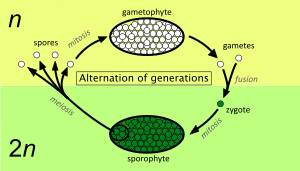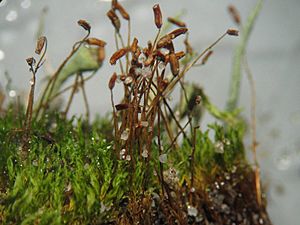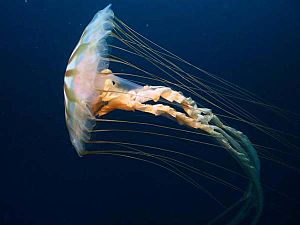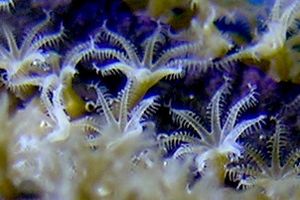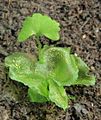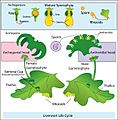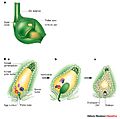Alternation of generations facts for kids
The term alternation of generations describes a cool way some living things, like plants and certain tiny organisms called protists, live their lives. It means they switch between two main forms during their life cycle.
One form is called the sporophyte. It has two sets of chromosomes (we call this diploid). Think of chromosomes as instruction manuals for building the organism. Having two sets means it has a backup!
The other form is called the gametophyte. This form has only one set of chromosomes (we call this haploid). Both the sporophyte and gametophyte are multicellular, meaning they are made of many cells.
In sexual reproduction, most organisms have a haploid stage and a diploid stage. For animals, our main body is usually diploid, and only our tiny gametes (sperm and egg cells) are haploid. But in plants, both the haploid and diploid stages are full-grown, multicellular organisms!
A great example is mosses. The green, leafy part you see is the haploid gametophyte. The little stalk that grows out of it, which helps with reproduction, is the diploid sporophyte. They often grow together, as you can see in the pictures.
It's important to know that "alternation of generations" is about the sexual part of a life cycle. Organisms can also reproduce asexually. Also, don't confuse this with animals that change how they look (like a caterpillar turning into a butterfly). In those cases, all the cells still have two sets of chromosomes.
Contents
How Plants Use Alternation of Generations
The idea of alternation of generations is super important for understanding how plants have changed over millions of years. All land plants today use this method.
Different Plants, Different Generations
In plants like mosses and their relatives (called Bryophytes), the haploid gametophyte is the main part of the plant you see. The diploid sporophytes are smaller stalks that grow right out of the gametophytes and depend on them for food.
For ferns, the diploid sporophyte is much bigger and is the fern plant you usually recognize. But the haploid gametophyte is also a small, flat plant that can live on its own for a while.
In flowering plants (Angiosperms), the sporophyte generation is almost the entire plant – the leaves, stems, roots, and flowers. The haploid gametophyte parts are very tiny and are found inside the reproductive structures, like the pollen and the ovule.
The Plant Life Cycle: Spores, Gametes, and Zygotes
The sporophyte plant makes spores. It does this through a special process called meiosis, which cuts the number of chromosomes in half. These spores are haploid.
Each spore then grows into a gametophyte. Since the spores were haploid, the gametophyte is also haploid. The mature gametophyte then produces male or female gametes (like sperm and egg cells) through a process called mitosis.
When a male gamete and a female gamete join together (this is called fertilization), they form a zygote. This zygote is diploid because it now has two sets of chromosomes again. The zygote then grows into a new sporophyte, and the cycle continues! This whole process is what we call alternation of generations.
How Alternation of Generations Helped Plants Evolve
Scientists like G. Ledyard Stebbins have studied how this switching between generations helped plants become so diverse. He noted that animals are usually diploid all the time, but plants have a haploid stage that lasts for a longer or shorter time.
Being diploid (having two sets of chromosomes) gives plants more flexibility. If a new mutation (a change in the genetic instructions) happens, and it's a "recessive" one, it can be hidden by the other, "dominant" set of instructions. This means that potentially useful new traits can be stored in the plant's genes without immediately being affected by natural selection. This "storage" of different gene versions (called alleles) helps plant populations have lots of variety, which is important for adapting to new environments.
Algae, Mosses, and Vascular Plants
Most algae have a dominant gametophyte stage. But in some types, the gametophytes and sporophytes look very similar.
Bryophytes (like mosses, liverworts, and hornworts) have a dominant gametophyte. The sporophyte grows right on the gametophyte and gets its food from it.

In all clubmosses, horsetails, ferns, gymnosperms, and angiosperms (flowering plants) that exist today, the sporophyte is the main, dominant form that can live on its own.
Early Plant Evolution and Seeds
Long ago, early land plants had sporophytes that made spores that all looked the same. But over time, the ancestors of gymnosperms (like pine trees) started making two different kinds of spores:
- Female megaspores were larger and fewer in number.
- Male microspores were smaller.
These megaspores stayed inside the parent sporophyte. Inside these megaspores, tiny female gametophytes grew, complete with egg cells. The egg cells were fertilized by tiny male gametophytes (which were like early pollen) carried by the wind.
The new zygote then grew into the next sporophyte generation while still protected inside the female megaspore, which was still inside the parent plant's spore-producing part (the sporangium). This amazing step was crucial for the evolution of seeds, which are so important for gymnosperms and angiosperms.
Similar Life Cycles in Other Organisms
Some other groups of organisms, like certain Chromalveolata, some fungi, and some slime moulds, also seem to have a true alternation of generations. These groups are very diverse, so it's hard to say exactly how common this is among them.
Why Animals Are Different
Animals do NOT have alternation of generations where both a multicellular diploid and a multicellular haploid generation exist.
Sometimes, people mistakenly call different life cycle stages in animals "alternation of generations." But this is different from what happens in plants. In animals, these different stages are all diploid. Often, only one of these stages reproduces sexually.
For example, jellyfish have two distinct forms: the medusa (the free-swimming jellyfish you see) and the polyp (a stationary form that attaches to surfaces). They look very different, but both are diploid. Only the medusa reproduces sexually.
Other animals, especially parasites like certain flukes, have complex life cycles where they live in different hosts (like snails for one part of their life and vertebrates for another). But again, these stages are all diploid.
In some cases, an animal's life cycle might have many generations, but only one of them reproduces sexually. For example, aphids can have one generation that reproduces sexually, and then up to forty generations that reproduce asexually through a process called parthenogenesis.
Images for kids
-
Gametophyte of the fern Onoclea sensibilis (the flat plant at the bottom) with a new sporophyte starting to grow from it (the small leaf at the top).
-
Life cycle of Foraminifera showing alternation of generations.
See also
 In Spanish: Alternancia de generaciones para niños
In Spanish: Alternancia de generaciones para niños


